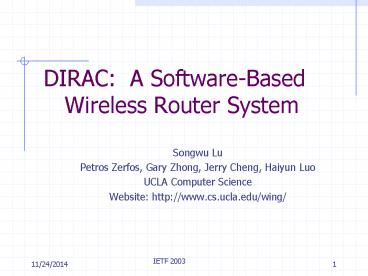DIRAC: A Software-Based Wireless Router System - PowerPoint PPT Presentation
Title:
DIRAC: A Software-Based Wireless Router System
Description:
Wireless Access Routers. Placed at the edge of the network ... Several wireless 'edge' services. Internet. Access Router. Access Point. 8/10/09. 3. IETF 2003 ... – PowerPoint PPT presentation
Number of Views:66
Avg rating:3.0/5.0
Title: DIRAC: A Software-Based Wireless Router System
1
DIRAC A Software-Based Wireless Router
System
- Songwu Lu
- Petros Zerfos, Gary Zhong, Jerry Cheng, Haiyun
Luo - UCLA Computer Science
- Website http//www.cs.ucla.edu/wing/
2
Wireless Access Routers
Access Router
- Placed at the edge of the network
- IP-connectivity first/last hop for hosts
- Moderate Load/ Traffic
- Several wireless edge services
Internet
Access Point
3
Outline
- Motivation for a Wireless Router Design
- Design Implementation
- Wireless Network Services
- Task
- Service
- Performance Evaluation
- Related and Future Work
4
Issues
- Wireless channel
- Fluctuating quality
- Location-dependent / High BER
- Mobility-sensitive
- Shared limited bandwidth
- Bandwidth much lower than the wired counterpart
- Host mobility
- Between adjacent cells Micro-mobility
- Between distant places Macro-mobility
- Open nature / Security implications
- No physical protection (wire)
5
New System Requirements
- New services and protocols for wireless networks
- Require additional link-layer support
- triggers for micro-mobility management (Perkins
et al Fast Handovers for MIPv6) - Knowledge of channel quality (channel-adaptive
schedulers) - physical disconnection of clients (access
control, firewall)
6
The Problem
- Difficult to implement wireless services and
protocols on wired routers - System support for implementation and deployment
is insufficient - Access points provide a simple bridge
- Access Router is unaware of the wireless
activity
7
Goals for Wireless Router
- Wireless systems platform
- Facilitate Experimentation, Implementation and
Deployment of Wireless Network Services - Improve performance over wireless networks
- Expose link-layer information and mechanisms
- Features
- Low cost of deployment
- Manageability
- Controlled complexity
8
Design Spectrum
Oblivious Approach
Integrated Approach
- Convert every AP to AR
- Collapse L2 and L3 layers
- Increased Cost
- Complicated Management
- Current practice
- No interaction between AR?? APs
- Difficult to implement wireless router services
9
DIstributed Router ArChitecture
- Router Core (RC)
- Main Forwarding
- Wireless Services
- Router Agents (RAs)
- Interact with RC
- Report L2 info
- Make available L2 mechanisms
RC
- Characteristics
- Access Points become External Interfaces
- Router makes informed, and adaptive forwarding
decisions
RA
RA
RA
10
Interactions (1) Events
Access Router
Events
New Host (Association)
Host Leaves (Disassociation)
Security Binding (Authentication)
Roaming Host (ReAssociation)
Power Saving Mode (PS)
Access Point
Roaming Host!
11
Interactions (2) Actions
Access Router
Actions
Accept/Reject Host (Association)
Authenticate Deauthenticate
Set Max Retxmit Count
Set Security Keys (WEP)
Access Point
DeAuthenticate!
12
Interactions (3) Statistics
Access Router
Statistics
SNR (dB)
Frame Loss ()
CommTallies
Latency
Channel Quality Variation
Access Point
13
Router Core Design
14
Router Core Implementation
- Runs on commodity PC hardware
- Implemented as elements in the Click router
framework - Runs the IPv6 protocol
- Application Programming Interface
- Communication Protocol RC ?? RAs
- Prototype Wireless Services as elements
15
Router Agent Implementation
- Open AP platform (AMD Elan SC400)b
- besides basic bridging
- Linux Wireless Extensions for monitoring
- 802.11 frame snooping for events
- Custom-made frames to enforce actions
16
Systems Overhead
- Microbenchmarks
Operation Time(ns)
Action 498
Event 1712
Statistics Report 32
Basic Forwarding 1299
- Taken on the RC
- Intel Pentium III _at_ 900Mhz
- 256Mb RAM
- Intel Ethernet Express 10/100
17
Wireless Network Services
- Wireless-specific services
- Link-Layer-Informed Fast Handover
- Channel-adaptive Data Forwarding
- Link-Layer-Assisted Policing
- Features
- Span both control and data planes of router
- Demonstrate the usefulness of the architecture
18
Micro-mobility management
CN/HA
- CN transmits CBR traffic to MN
- 50packets/s 512bytes/packet
- L2 handoff latency about 400ms
AR1
AR2
AP1
AP2
MN
19
1st Service Fast Handovers
Old AR
New AR
- Mobile node-initiated
- No movement prediction
- 802.11 ReAssociation event as trigger
AP
MN
20
Fast Handover Latencies
Mean Median stdv
Tunnel Establishment 4.2 3.6 1.5
Additional latency to complete L2 assoc. 7.9 7.4 1.8
Time to send new IP/GW 18.6 18.8 3
Time for MN to change IP/GW 8.1 6 6
latencies are in milliseconds
21
Head-of-Line blocking
- Downlink forwarding path (AP ? MNs)
- For a node experiencing low channel quality
HoL Packet
Wireless I/F
...
22
2nd Service Channel-Adaptive Downlink Forwarding
- Feedback on channel quality from the Router
Agent - Router Core requests disabling of retransmissions
- FEC implemented on the RC
- FEC compensates for loss of reliability
- Strength of FEC adaptive to transmission rate and
quality of the channel - Nodes with good channel do not experience any
packet drops
23
Downlink Forwarding Results
packets received by each node, out of the 10,000
sent
Average quality stdv MN1 MN2 MN3
10.38 1.53 9903 9830 2647
12.38 1.46 9980 9940 7450
15.02 2.01 9980 9978 9581
20.17 1.54 9943 9903 9985
Average quality stdv MN1 MN2 MN3
9.47 2.17 4808 4807 3038
12.21 1.81 7559 7554 6558
14.81 1.76 9999 9999 9822
20.44 1.98 9999 9999 9988
FEC-based approach
Link-layer retransmissions
24
Related Work
- Software-based, Wired Routers
- Click, Scout, Router Plugins, XORP
- Explore issues on extensibility, flexibility,
modularity - Cross-layer interactions Mobiware toolkit
- Commercial solutions emphasis on security
accounting, control plane only - Vernier Networks
- Aruba Networks
- Nomadix
25
Summary
- Distributed Router Architecture
- motivated by wireless-adaptive and mobility-aware
service - Two-way interaction between Access Routers
Access Points - Enable implementation of wireless router services
- Low cost of deployment/management
- Ongoing Work
- 4th Service Coordinated Inter-domain Firewall
- Coordination with Middleware































